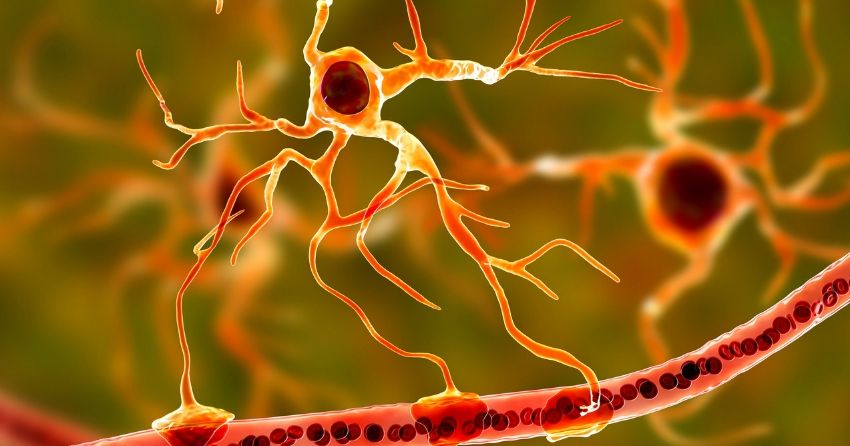Overactive Astrocyte Cells Explain Unpredictability of Alzheimer's Disease

-
The star-shaped astrocytes in the brain may explain why some people with Alzheimer's disease (AD) don't respond after amyloid plaques are removed and why some people with high levels of amyloid plaques don't have AD.
-
Astrocytes change their shape and function as AD progresses. Researchers found that 'reactive astrocytes' are a key indicator of AD onset.
-
Mildly reactive astrocytes can naturally reverse their reactivity, while severely reactive astrocytes cause irreversible neurodegeneration.
-
Oxidative stress can transform mildly reactive astrocytes in neurotoxic and severely reactive astrocytes.
This article was posted on the Institute for Basic Science News:
Though Alzheimer's disease (AD) is a common and fatal neurodegenerative brain disorder, most of AD treatments seem to not be making much headway to unravel the mystery of its cause. Many AD drugs have targeted the elimination of beta-amyloid (A?) or amyloid plaques, which block cell-to-cell signaling at synapses.
But some AD patients continue to show neurodegeneration and cognitive decline even after the removal of the amyloid plaques.Conversely, many people indicate no signs of neurodegeneration and cognitive impairment even in very high level of A?. Also, it has never been precisely clear as to why the star-shaped non-neuronal cells, called astrocytes, change in their shapes and functions from the early onset of AD, and continue such reactive state throughout the AD progression.
Researchers at the Center for Cognition and Sociality, within the Institute for Basic Science (IBS) and Korea Institute of Science and Technology (KIST) have demonstrated that the severity of 'reactive astrocytes' is a key indicator for the onset of AD, raising profound implications of the current theory of AD mechanism. In its toxin-receptor-based animal model, the research team fine-tuned astrocytic reactivity in vivo.
They found that the mild reactive astrocytes can naturally reverse its reactivity, whereas severe reactive astrocytes can cause irreversible neurodegeneration, brain atrophy and cognitive deficits, all within 30 days. Notably, this severe-reactive-astrocyte-induced neurodegeneration was successfully replicated in virus-injected APP/PS1 mice, which have been widely known to lack neurodegeneration. These results indicate that severe reactive astrocytes are sufficient for neurodegeneration.
"This finding suggests experiences such as traumatic brain injury, viral infection, and post-traumatic stress disorder might be needed to transform a healthy brain to be vulnerable to Alzheimer's disease via excessive oxidative stress," says Director C. Justin LEE (at IBS), the study's corresponding author.
"The excessive oxidative stress disables the body's ability to counteract the harmful effects of overproduced oxygen-containing molecules, subsequently transforming mild reactive astrocytes into neurotoxic severe reactive astrocytes," explains Dr. Lee. The team revealed that toxin-responsive astrocytes activate a cellular restoration mechanism (or autophagy-mediated degradation pathway) and increase hydrogen peroxide (H2O2) by triggering monoamine oxidase B (MAO-B). MAO-B plays an important role in the reduction of dopamine that hinders the signal transmission to produce smooth, purposeful movement.
Such mechanistic system results in morphological hypertrophy of astrocytic processes followed by a cascade of neurodegenerative events: turning-on of the nitric oxide synthesizing enzyme iNOS, nitrosative stress, microglial activation and tauopathy.
The research team verified that all of these events of the AD pathology were halted by a recently developed reversible MAO-B inhibitor, KDS2010 or a potent H2O2 scavenger, AAD-2004. This reinforces that severe reactive astrocytes are the cause of neurodegeneration, not the result of it as previously assumed, notes Director Lee. Finally, these molecular features of the severe reactive astrocytes are commonly shared in various animal models of AD and in the brain of human AD patients.
This study offers plausible explanations for why AD has been so unpredictable: neurodegeneration cannot be reversed once severe reactive astrocytes are on; and mild reactive astrocytes can be recovered unless being stretched by other pathological burdens.
"Notably, this study suggests that an important step to establishing a new treatment strategy for Alzheimer's disease should be by targeting reactive astrocytes that appear to be overly activated in the early stages," says Dr. RYU Hoon (at KIST), another corresponding author of the study. This should be accompanied by the development of the diagnostic tools for reactive astrocytes and early Alzheimer's disease, adds Dr. Ryu.
Dr. CHUN Heejung (at IBS), the first author of the study says, "The reactive astrocytes are a general phenomenon occurring in various brain diseases such as Parkinson's disease and brain tumors, as well as Alzheimer's disease. Building upon this study, we have plans to expand our mechanistic insights of the reactivity-dependent neuronal death into other brain diseases for which treatment has not yet been developed."
This study was published in Nature Neuroscience in November 2020.





